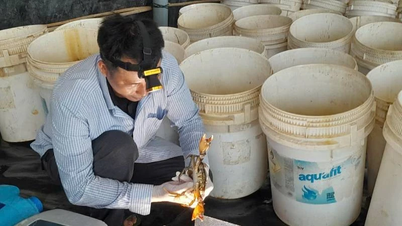1. How do liver flukes cause disease in humans?
Liver fluke is a parasite that enters the human body through the digestive tract and causes disease in many organs, but mainly in the liver and bile duct.
Liver fluke disease includes small liver fluke disease and large liver fluke disease.
- Large liver fluke: The main host is herbivores such as buffalo and cows; humans are only secondary hosts, the intermediate host is the snail family Lymnanea. People are infected by eating raw aquatic vegetables (such as Vietnamese coriander, watercress, watercress...) or using water sources contaminated with liver fluke larvae.
- Small liver fluke: The main hosts are humans and some animals such as dogs, cats, tigers, leopards, foxes, ferrets, rats. The first intermediate host is the snail Bythinia, Melania, the second intermediate host is freshwater fish.
2. Who is susceptible to liver fluke disease?
According to research, most cases of liver fluke infection are people who often eat raw food, salads, aquatic vegetables..., live along rivers, near livestock areas such as buffalo, cows, sheep; or people with a history of eating raw fish caught in endemic areas (areas where liver fluke disease is prevalent).
People infected with liver flukes often eat fish or snails infected with uncooked fluke larvae. After eating, the larvae will enter the stomach, go down the duodenum, then follow the bile duct to the liver, then develop into adult liver flukes that parasitize and reproduce in the bile duct.
3. Signs of liver fluke infection
Symptoms of small liver fluke infection:
- Patients often have symptoms of pain in the liver area due to the reproduction of worms causing blockage of the bile ducts in the liver, leading to pain in the right hypochondrium.
- Digestive disorders (poor appetite, bloating and indigestion).
- Sometimes there are signs of skin darkening, jaundice and signs of enlarged liver or cirrhosis depending on the severity of the disease.
Symptoms of liver fluke infection:
- Pain in the right hypochondrium radiating to the back or pain in the epigastric region and sternum; the pain is nonspecific, can be dull, sometimes severe, and sometimes without abdominal pain.
- Patients are tired, feel full, have indigestion, digestive disorders, nausea, may have fever or joint pain, muscle pain and rash...
- Some cases of parasitic worms in different places such as in the lungs, under the skin of the chest...

Digestive disorders are common symptoms of liver fluke disease. Illustration photo.
4. Is liver fluke infection dangerous?
In severe cases, small liver flukes can cause cholangitis, biliary bleeding, biliary tract cancer, biliary cirrhosis...
In some cases, large liver flukes cause liver abscesses, causing severe pain in the right lower quadrant, fever, and enlarged liver. If the abscess ruptures into the lungs, it can cause pleural effusion, making the condition serious.
It should be noted that the symptoms of liver fluke disease are similar to other liver diseases such as viral hepatitis, cholangitis due to gallstones, liver cancer or liver abscess due to other causes... Therefore, patients need to be examined carefully to have appropriate treatment measures.
5. Treatment of liver flukes
Treatment of liver flukes is mainly medical treatment with antiparasitic drugs. The drugs need to be prescribed early and in the correct dosage as prescribed by the doctor. The patient needs to be re-examined after 3 months and after 6 months of treatment.
6. Can oriental medicine cure liver fluke disease?
Oriental medicine can support the treatment of liver fluke disease with remedies that have the effects of eliminating worms, disinfecting, clearing heat, detoxifying the liver...
However, it should be noted that Oriental medicine only has a supportive effect on treatment. To accurately diagnose and treat liver flukes, it is necessary to combine information on epidemiological characteristics, clinical symptoms and paraclinical tests at a specialized medical facility.
7. How to care for patients with liver fluke disease
When diagnosed with liver flukes, patients need to be treated early, using specific drugs and adequate doses as prescribed by the doctor. In addition, it is necessary to have a reasonable diet and improve physical condition.
Patients must comply with the doctor's treatment regimen. Take the full course of medication, in the correct dosage and at the prescribed time. Do not take medication on your own advice.
In addition, it is necessary to pay attention to a reasonable living and resting regimen; Maintain personal hygiene, wash hands regularly; Exercise regularly according to health; Get enough sleep; Avoid stress...
It is necessary to have a complete, balanced diet, ensuring adequate supply of calories, protein, vitamins and minerals for the body. Prioritize fresh, easy-to-digest foods, rich in fiber; Drink plenty of water; Limit fat and foods that are difficult to digest such as fried foods, greasy foods, spicy foods, foods with lots of spices, alcohol, stimulants, etc.
8. Can liver flukes be prevented?
Liver fluke disease is mainly caused by people's hygiene and eating habits, so disease prevention mainly includes the following measures:
- Make sure to eat cooked food and drink boiled water, do not drink raw water.
- Use water from clean, hygienic sources.
- Do not eat raw aquatic plants near livestock areas.
- Do not eat raw fish or other undercooked fish.
- Periodically deworm livestock.
- People suspected of having liver flukes must go to a specialized hospital for examination and treatment.

If liver fluke infection is suspected, the patient should see a doctor and do the necessary tests.
9. What tests are needed to determine liver fluke infection?
Tests for liver flukes are often performed as stool tests for fluke eggs, complete blood biochemistry and hematology tests, and tests for liver fluke antibodies in serum...
In addition to liver fluke tests, doctors may order patients to perform some imaging diagnostic techniques to help detect liver fluke disease such as: general ultrasound of the hepatobiliary area, chest X-ray, CT scan, MRI...
When diagnosed with liver flukes, depending on the type of liver fluke, the patient will be treated according to the appropriate regimen. If treated early, the treatment is often favorable, the patient often responds to the medication and recovers completely. If the disease is detected and treated late, the damage caused by liver flukes to the patient's body will be more severe, treatment will be much more difficult and complicated.
10. Where to get tested for liver flukes?
Liver fluke infection in humans often has symptoms such as: nausea, digestive disorders, loss of appetite, anemia, weight loss...
When having the above signs, especially when having a history of eating raw fish, drinking raw water, regularly eating raw aquatic vegetables or living in localities with high rates of disease, patients should go to medical facilities with parasitology specialists to do accurate diagnostic tests for effective treatment.
Source



![[Photo] Impressions of the Can Gio Whale Festival](https://vphoto.vietnam.vn/thumb/1200x675/vietnam/resource/IMAGE/2025/10/09/1759984089762_image12334-5642-jpg.webp)























![[Photo] Prime Minister Pham Minh Chinh inspects and directs the work of overcoming the consequences of floods after the storm in Thai Nguyen](https://vphoto.vietnam.vn/thumb/1200x675/vietnam/resource/IMAGE/2025/10/08/1759930075451_dsc-9441-jpg.webp)
![[Photo] Prime Minister Pham Minh Chinh attends the World Congress of the International Federation of Freight Forwarders and Transport Associations - FIATA](https://vphoto.vietnam.vn/thumb/1200x675/vietnam/resource/IMAGE/2025/10/08/1759936077106_dsc-0434-jpg.webp)


































































Comment (0)